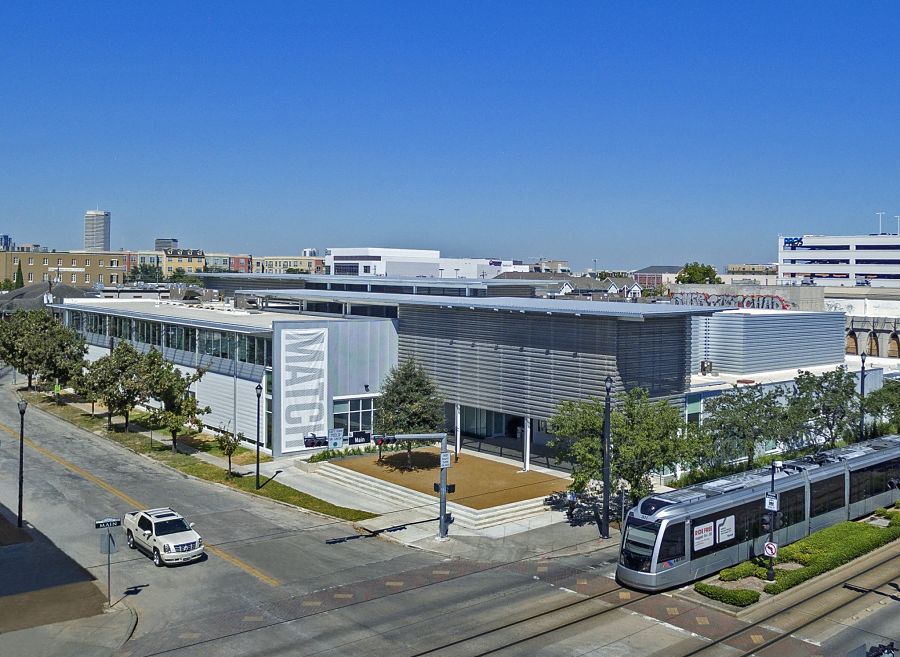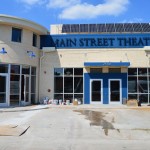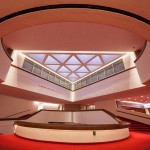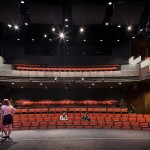HOUSTON: The aphorism “a rising tide lifts all boats” is a fitting slogan to sum up the recent economic success Houston has enjoyed. Known predominantly as an oil town, the city benefitted greatly after the Great Recession and saw the energy sector skyrocket, kickstarting a new wave of opportunity, immigration, and wealth in the fourth largest city in the United States.
The escalation of the tide, however, has flowed well beyond commercial and corporate endeavors, right into the open and needy arms of the arts sector. For those whose interests are on a stage as opposed to the stock market, the capital influx of the last six years enabled a reimagining of places and spaces that could be as theatrically grand as the productions within their walls.
Dubbed by many as a veritable Houston theatre building renaissance, 2015–17 will see no less than five new or newly renovated theatres open their freshly painted doors to patrons. Some, like the Alley Theatre (Houston’s largest and most monied companym known for innovative productions of classics, neglected modern plays, and premieres) and the eclectically programmed midsize Main Street Theater, chose to significantly renovate their existing spaces. Suburban Queensbury Theatre kept their footprint in a demolish-and-rebuild process, while A.D. Players opted for a change of address to stage their spiritually minded shows. Lastly, but perhaps most exciting for the city, is the introduction of the Midtown Arts & Theatre Center (MATCH), which will bring the concept of the modern theatre complex to the burgeoning midtown neighborhood.
With a price tag of $46.5 million, the Alley Theatre’s transformation by Studio RED Architects is by far the most talked about—and not just because patrons, posh and otherwise, had to truck out to the company’s temporary off-campus home at the University of Houston last season while work was underway. Most of the renovation, which began in July 2014, took place within Ulrich Franzen’s 1968 landmark concrete-colored brutalist building, out of sight of curious eyes. It was just over a year later, at the company’s October 2015 season launch, that audiences got to witness what all the money and time had been spent on.
When the doors opened, patrons were greeted with glossed-up public spaces, a reconfigured stage (from proscenium to thrust), and 50 fewer seats (774 from the previous 824) in an effort to increase intimacy between actors and audience. But more importantly, the renovation was an artistic modernization that allows the company’s mainstage Hubbard theatre to function within present production style.
“In the 1960s, when the Alley was built, there was an anti-scenery minimalist style,” says Alley artistic director Gregory Boyd. “Set design in theatre wasn’t a big thing at the time, so we didn’t have a loading dock or wing space to move scenery into the building or onto the stage.”
But as the trend moved toward larger and more complicated design, Alley staff were forced cut up set pieces small enough to fit into a compact lift and reassemble the scenery on and off the stage. With the addition of a four-story fly loft, a large trap room, and a side stage with direct access to a loading dock, Boyd boasts that the Alley is now one of a kind. “We are the only repertory theatre in North America committed to the resident company ideal that has one of the largest state-of-the-art production facilities next to a state-of-the-art performance facility.”
A.D. Players embraces a more modest stance when talking about its new uptown location, set to partially open in early 2017. “We’re not spending on extras,” says the company’s chairman of the board Susan Santangelo. “Our theatre will be beautiful but not opulent. We didn’t want a signature in the community that we over spent.”
Perhaps easy to say about a development with an $18 million price tag and a $2 million gift from Houston Texans owner Bob McNair, but then A.D. Players is putting a lot of theatre into one locale. Conceived to consolidate all that the company offers into one single location during two phases of building, the Lorraine George Performing Arts Center (named in honor of the late husband of A.D. Players’ founder and artistic director, Jeannette Clift George) will include a 450-seat mainstage, a 300-seat children’s theatre, and a 150-seat black box space.
Designed by Gabriel Architects of Houston, the new A.D. building’s address is generating as much buzz as the modern curving glass and grey clad structure itself. Located just a few blocks west of the Galleria shopping complex, the eighth largest mall in America, A.D. Players (which owns the four acres of land the building will occupy) will be the only major theatre venue in an area that is otherwise a cultural black hole without even a movie theatre to its name.
“Right from the start A.D. Players made a choice to show a certain kind of show,” says Santagnelo. “By offering uplifting family theatre in an area so populated by Houstonians and visitors alike it will allow us to enhance the area, reach more people, and raise awareness of not only what we do but the power of theatre and the impact it can have.”
While A.D. Players is moving into an area that’s already a going concern, Queensbury Theatre (formerly the Country Playhouse) has seen its area grow up around it. Built in 1981 in the West suburban retail area of Houston, Queensbury Theatre is now smack dab in the middle of the CityCentre, an upscale mixed-use development chock full of condos, restaurants, and trendy retail storefronts. With all the money-making glitz going on outside its doors, Queensbury realized it was time for a makeover.
“The gentrification of CityCentre was our opportunity to take the next step and upgrade our facility to the next level”, says John Paul Stevenson, president of Queensbury Theatre. “But we needed substantial upgrades and that meant starting from scratch with a demolition as opposed to renovation.”
To fund the project, the company engaged in a land transfer of some of the 2.7 acres it sat on, freeing up $7.5 million for the project. The new glass and silver-beamed design by Kirksey Architecture allowed the theatre to keep its general footprint while doubling in size vertically to 22,000 sq feet including a 200-seat mainstage (featuring safe crowd-pleasing shows), a 100-seat black box (for edgier shows). With the building’s swanky new look, Stephenson thinks the theatre can capture a whole new audience based on locale.
“We are uniquely poised to see some younger demo with the live/play makeup of CityCentre,” he says. “Here you can park for free, have dinner across the street and 10 minutes from getting bill, you’re in your seat.”
A close dinner has always been a selling point for Main Street Theatre—parking not so much. Located in the pedestrian-friendly but automotively tricky Rice Village commercial neighborhood, Main Street has the zipcode privilege of the highest concentration of arts patrons in the city, but with the theatre’s dated and somewhat shabby facility, those numbers were just not translating into ticket sales.
“Anyone who goes to theatre in NYC knows it’s not the building, it’s what’s on the stage that matters,” says Main Street’s founding artistic director Rebecca Udden. “Houstonians will shell out $200 for a touring production of Book of Mormon but would dismiss us based on looks. Or they simply didn’t even know we were here because of the lack of attractiveness factor.”
That will all change once the renovations (designed by Studio RED Architects) are complete in November, timed to coincide with the theatre’s 40th anniversary season. Main Street purchased their mainstage property in 2008 and in 2012 began work on their $3.5 million renovation to update public and backstage spaces, improve technical abilities including a tech booth that can finally have a live view of the stage, thoroughly modernize their 99-seat black box stage and create a second story dedicated to classroom and rehearsal space.
“We’ve been very efficient for a long time, making do with very little and doing a lot,” says Udden who believes the biggest impact of the renovation will be the companies set design abilities thanks to a doubling in the theatre’s ceiling height to 18 feet from the bottom of the grid. To highlight her point, Udden harkens back to a production that called for a character to fall down a flight of stairs.
“We didn’t have the height ability to build a tall staircase in our theatre so our designer and director were forced to come up with a way to have an actor believably topple down just a few steps”, says Udden. “The new building will give us the ability not to have to work as hard—or at least work hard on different challenges.”
One of the new challenges Main Street will be facing is the location of their children’s theatre and all the company’s offices offsite at the new MATCH complex. In fact, a lot of companies will be leaving their old, often dilapidated digs to put on shows in the new complex that might prove to be a game changer for smaller theatre in Houston. “Houston is an unusual place,” says MATCH executive director Chuck Still. “We have a really well-funded theatre district but not a lot of middle ground so there’s a huge gap in financial resources and spaces for medium to small.”
Located in an up-and-coming midtown area, MATCH is a modern but inviting complex that houses four theatres ranging in size from 90 to 329 seats comprised of one main proscenium stage, two black box theaters, a dedicated dance theatre, a large gallery, and office spaces. Over a decade in planning, the $25 million complex finally moved ahead in 2014 and celebrated its soft opening at the start of October.
What MATCH will offer these smaller companies like Main Street, Theatre LaB, Lott Entertainment, Next Iteration Theatre, Black Lab, and Catastrophic who will all be performing there this season, is access to the same quality technical and facility resources that the big guys have and the ability to show audiences what they can do with it. If Still gets his way though, the folks performing in MATCH today will not be the ones who continue to perform there year after year.
“It would be great if we could give these companies a space and nurture/help them a bit and then they outgrow us and move on,” says Still who hopes that this will make room for another batch of existing or newly formed smaller companies to move in.
Whether putting on a small production in a new space like MATCH or the Alley with their 500 performances a year, all these newly housed theatremakers are now facing the same challenge—namely the launch of their fresh spaces in a less economically friendly time than when they started planning some six years or so ago. Maybe it’s the thrill of their shiny new buildings or maybe they’ve just been through it all before in one way or another, but none of the company leaders seemed all that worried.
“Sure the current economy is a challenge for all non-profit arts organization,” says Stevenson. “But the reason all these projects took place in the first place is that Houston is a city with a deep appreciation for the arts and values the quality of life assets of living in a culturally vibrant city.”
Boyd is more succinct about what all these new theatres will mean for the cultural landscape in the city regardless of the daily price of oil. “New buildings give people new reasons to go to the theatre,” he says. “It’s good for all of us.”
Jessica Goldman is a theatre critic with the Houston Press and her reviews can also be found on applause-meter.com.











